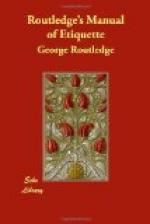What then is the reason why dress has become so expensive? Is it because the materials which are in use are costly, or is it because the needlewomen are better paid, and, wages being higher, dressmakers’ charges are also higher in proportion? We do not believe that either of these are the cause; but simply that a larger quantity is required, and that variety has become a “sine-qua-non.” Some years ago the cost of a silk dress was about half what it is now,—not because the price of silk has increased, but because a much larger quantity is required. Perhaps of the two, silk is cheaper than it used to be; but where ten and twelve yards sufficed, twenty and twenty-three are scarcely sufficient. Then the variety that is considered indispensable adds to the cost of dress. Where three or four dresses constituted the wardrobe of many, three times that number are now considered a scanty supply. Some ladies do not like to wear the same dress twice at the same place; and, if they visit in the country, take with them luggage enough for a twelvemonth, and appear daily, and, in some instances, three times a day, in some fresh costume. It may perhaps be said that these are exceptional cases, but they are not so. Ladies-maids, servants, and even village girls have more gowns now than persons of the same class had formerly. This adds to the cost of dress, and makes it altogether a more expensive affair than it used to be. Our fore-mothers who rejoiced in farthingales had, no doubt, the most costly attire, but it lasted longer, and became the inheritance of children and children’s children; besides which their wardrobes were not by any means so expensive as that of a “grande dame” of 1875.
Materials are an important element in the matter of dress, and we propose, in the few remarks we shall make on the subject of expense, to offer some suggestions which shall tend to make it less.
In the first place every young lady is without excuse who spends a large sum annually upon her dress, for she possesses in her youth that which makes the most simple and inexpensive attire the most suitable and becoming. Everything is appropriate to youth. The freshest flowers of the garden, the plainest muslins, tarlatans and tulles do not come amiss. In the country fresh flowers are more admissible than those that are artificial. In London it is the reverse. The heat of a crowded ball-room soon makes the brightest flowers wither; besides which there would be an affectation in a young lady’s making her appearance in a London ball-room decked, like the goddess Flora, with real flowers; while all the world prefer the artificial as the least troublesome and the most enduring.




